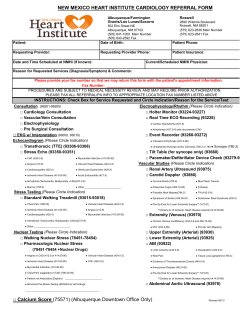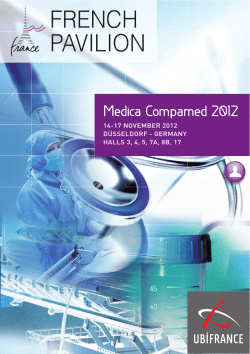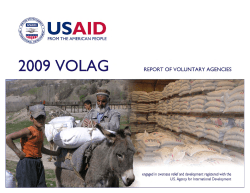
Lipoprotein(a) : Lp(a) Proven to be the best
Lipoprotein(a) : Lp(a) Proven to be the best methodology on the market Background Cardiovascular disease (CVD) and more specifically, Myocardial Infarction (MI) remains a leading cause of morbidity and mortality, despite the targeting of LDL cholesterol via statin therapy. There is a need for additional causal risk factors, beyond the traditional LDL measurement1. Large scale studies and international guidelines published between 2009 and 2010, have proven that Lp(a) is a major independent genetic risk factor for premature CVD and should be screened in all patients at moderate to high risk. What is Lipoprotein(a) : Lp(a)? • Lp(a) is a major independent genetic risk factor for cardiovascular disease2 • Lp(a) particles are similar to LDL consisting of a cholesterol-rich core, with an apoB-100 protein attached3 • However, Lp(a) uniquely differs to LDL in that it also has an apo(a) protein attached via a disulfide bond (see diagram) • The apo(a) is comprised of a series of kringle structures • There are 10 types of kringle IV and only one copy of each type except for type 2. Kringle IV, type 2 (KIV2) is particularly susceptible to being manufactured repeatedly, depending on an individual’s genetics (2-40 repeats) • The number of KIV2 repeats generates different isoforms and a major affect on the size of the apo(a) protein which affects the level of Lp(a) • Apo(a) is synthesised in the liver and binds to newly synthesised apoB-100 • The size of the apo(a) protein is genetically determined and varies widely1 hence, levels of Lp(a) can vary up to 1000-fold between individuals1 • Plasma levels rise shortly after birth up to a consistent level within several months, typical plasma levels of Lp(a) are similar in men and women: one in five (20%) have levels above 50 mg/dL. 2010 Guidelines on Lp(a) 4 Recent years have seen major scientific advances in the understanding of Lp(a) and its causal role in premature CVD. Elevated Lp(a) levels associate robustly and specifically with increased CVD risk. This association is continuous and does not depend on high levels of LDL or non-HDL cholesterol, or the presence of other CVD risk factors. Lp(a) levels, like elevated LDL, is causally related to premature development of atherosclerosis and CVD. Table I Comparison of evidence supporting the contention that elevated LDL cholesterol and elevated Lp(a) each cause cardiovascular disease4 Assay details Elevated LDL cholesterol Elevated Lp(a) Human epidemiology Direct association in numerous studies Direct association in numerous studies Human genetic studies Direct association in numerous studies, e.g. familial hypercholesterolaemia Direct association in numerous studies, e.g. for kringle IV type 2 polymorphism Mechanistic studies Mechanism clearly demonstrated: LDL accumulates in intima and causes atherosclerosis Mechanism similar to that for LDL cholesterol and/or prothrombotic/anti-fibrinolync effects Animal models Proatherogenic effect in numerous studies Proatherogenic effect in numerous studies Human intervention trials Statin trials gave final proof of causality Niacin trials are favourable Whom to screen? 4 The European Atherosclerotic Society suggest that Lp(a) should be measured once in all subjects at intermediate or high risk of CVD/CHD who present with: i. Premature CVD ii. Family hypercholesterolaemia iii. A family history of premature CVD and/or elevated Lp(a) iv. Recurrent CVD despite statin treatment v. ≥ 3% 10-year risk of fatal CVD according to the European guidelines vi. ≥ 10% 10-year risk of fatal and/or non-fatal CHD according to the US guidelines Repeat measurement is only necessary if treatment for high Lp(a) levels is initiated in order to evaluate therapeutic response. The evidence clearly supports Lp(a) as a priority for reducing cardiovascular risk, beyond that associated with LDL cholesterol. Clinicians should consider screening statin-treated patients with recurrent heart disease, in addition to those considered at moderate to high risk of heart disease - EAS Consensus Panel 5 Desirable Levels 4 Table 2 Desirable levels for low-density Lipoprotein cholesterol and lipoprotein(a) levels in the fasting or non-fasting state4 Patients with CVD and/or diabetes Other patients and individuals Highest level of evidence for treatment LDL cholesterol < 2 mmol/La (<77 mg/dL) < 3 mmol/La (116 mg/dL) la: meta-analysis of randomised, controlled trials of statin treatment Lp(a) < 80th percentile (<~50 mg/dLb) < 80th percentile (<~50 mg/dLb) la: meta-analysis of randomised, controlled trials of niacin treatment According to the 2007 European guidelines The 80th percentile roughly corresponds to 50 mg/dL in Caucasians. a b How to treat elevated Lp(a)? • Patients with moderate or high risk of CVD should be screened for Lp(a)1 • Reducing Lp(a) to below cut-off should be a treatment priority, along with the lowering of LDL cholesterol1 • Lp(a) levels are generally not strongly affected by lifestyle changes1 • In general, serial measurement of Lp(a) is not required and only needs to be repeated if evaluating therapeutic response • If Lp(a) is above cut-off the primary focus of treatment should be on reducing the patient’s risk.1 In addition, niacin therapy can be considered, particularly in high risk patients, as this has been shown to reduce Lp(a) by 30-40%.1 Niacin-based therapies have been shown to improve patients’ atherogenic lipid profile (increases HDL-C, decreases LDL-C, decreases Lp(a) and decreases triglycerides) • LDL apheresis which removes Lp(a) efficaciously8 should be considered in young or middle-aged patients with evidence of progressive coronary disease and markedly elevated plasma Lp(a)4 Choosing your Lp(a) assay Lp(a) levels are heavily influenced by the size of the attached apo(a) protein7. The size variation of apo(a) represents a serious challenge in the immunochemical measurement of Lp(a) for the following reasons7: i. The antibodies should have isoform-insensitive immunoreactivity to apo(a) ii. The choice of apo(a) size in the assay calibrator tends to be random and is not representative of all possible apo(a) size variations found in the general population iii. Depending on the size of apo(a) used in the calibrator, many commercially available assays either underestimate or overestimate the concentrations of Lp(a) in plasma – hence they are strongly affected by “apo(a) size-related bias” Utilisation of an inadequate methodology for Lp(a) is highly likely to lead to increased numbers of both false negatives and false positives7 . This will lead to the potential misclassification of a significant number of both high and low risk patients.7 Randox Lp(a) Assay Details Proven to be the best methodology on the market • T he Randox assay contains a very high density of isoform-insensitive antibodies and detection reagent – ensuring more Lp(a) bound antibodies are detected and more accurate measurement • Randox produces a 5-point calibrator which takes into account the heterogeneity of the Lp(a) molecule for each of the levels, resulting in excellent commutability of the calibrator with patient samples • Liquid ready-to-use IT assay • Excellent stability (open vial stability 30 days on board) • No sample preparation required • Fully automated applications available for a wide range of analysers Randox Lp(a) Assay Details High Performance Reagents Assay Range - 2.1-90 mg/dl. Sensitivity - 2.1 mg/dl. Precision - The following coefficients of variation were obtained on a Hitachi™ 717 analyser. Lipoprotein (a) Mean (mg/dl) n Product Description Size Cat. No. Lp(a) Kit 1x10 ml, 1x6 ml 1x30 ml, 1x15ml LP3403 LP2757 21.0 1.63 20 51.5 1.53 20 Lp(a) Kit for Dimension® 4x40 T LP2878 83.05 2.40 20 Lp(a) Calibrator 5x1 ml LP3404 24.19 3.11 20 Lp(a) Control (Level 3) 3x1 ml LP3406 32.58 3.52 20 Lipid Control (Level 1) 5x3 ml or 5x1 ml 50.48 2.83 20 LE2661 or LE2668 Lipid Control (Level 2) 5x3 ml or 5x1 ml LE2662 or LE2669 Lipid Control (Level 3) 5x3 ml or 5x1 ml LE2663 or LE2670 Intra-assay precision Inter-assay precision Mean % CV Instrument Applications Available for Randox Lp(a) Instruments Abbott Aeroset/Architect Manual Roche Cobas Integra 400 ABX Pentra 400 Menarini Alcyon 300/Alcyon Falcor Roche Hitachi 704 BS 120/200/300/400 Olympus AU400/AU600/AU2700 Roche Hitachi 717 BT 2000/BT3000/ILAB 300/Targa Olympus AU560 Roche Hitachi 747/Modular P CL 7200, ILab 1800, ILab 900 Olympus AU800/AU1000 Roche Hitachi 902 Express 550 Ortho Vitros Fusion Roche Hitachi 904/911/912 Humalyzer 850, Humalyzer 900S Prestige 24i/Saphire Roche Hitachi 917/P Module ILAB 600 RA 1000, RA Opera, RA XT Siemens Dimension ILAB 900/ILAB1800/Shimadzu CL 7200 Randox RX daytona, RX imola Synchron CX 4/5/7/9/LX20 Kone Progress, Kone Specific Roche Cobas 4000 Unicel 600/800 Konelab 20i/30i/60i Roche Cobas 6000 (c501) Technicron RA1000/RAXT/Opera Lisa 200-500/Mascott Plus/Clinline Roche Cobas FARA Vitalab Flexor/Selectra E/Selectra II References 1. Kamstrup PR, Tybjaerg-Hansen A, Steffensen R, Nordestgaard BG. Genetically elevated lipoprotein(a) and increased risk of myocardial infarction. JAMA 2009;301:2331-2339. 2. Erqou S, Kaptoge S, Perry PL, Di AE, Thompson A, White IR, Marcovina SM, Collins R, Thompson SG, Danesh J. Lipoprotein(a) concentration and the risk of coronary heart disease, stroke, and nonvascular mortality. JAMA 2009;302:412-423. 3. Utermann G. Lipoprotein(a). In: Scriver CR, Beaudet AL, Sly WS, Valle D, eds. The Metabolic and Molecular Bases of Inherited Disease. 8th ed. New York: McGraw-Hill; 2001. p. 2753-2787. 4. Nordestgaard BG, Chapman MJ, Ray K, Borén J, Andreotti F, Watts GF, Ginsberg H, Amarenco P, Catapano A, Descamps OS, Fisher E, Kovanen PT, Kuivenhoven JA, Lesnik P, Masana L, Reiner Z, Taskinen MR, Tokgözoglu L, Tybjærg-Hansen A; European Atherosclerosis Society Consensus Panel. Lipoprotein(a) as a cardiovascular risk factor: current status. Eur Heart J. 2010; 31(23):2844-53. RX imola Designed for medium to high throughout laboratories, the RX imola is a random access bench top clinical analyser with a maximum throughput of 560 tests per hour including ISEs. 5. http://www.eas-society.org/consensus-position-paper-initiative.aspx 6. Chapman MJ, Redfern JS, McGovern ME, and Giral P. Niacin and fibrates in atherogenic dyslipidemia: Pharmacotherapy to reduce cardiovascular risk. Pharmacol Ther 2010; 126:314-315. 7. Marcovina SM, Albers JJ, Scanu AM, Kennedy H, Giaculli F, Berg K, Couderc R, Dati F, Rifai N, Sakurabayashi I, Tate JR, Steinmetz A. Use of a reference material proposed by the International Federation of Clinical Chemistry and Laboratory Medicine to evaluate analytical methods for the determination of plasma lipoprotein(a). Clin Chem. 2000; 46(12):1956-67. 8. Thompson G.R. Recommendations for the use of LDL apheresis. Atherosclerosis 2008; 198:247-255. RX daytona Convenient bench top system, the RX daytona clinical analyser has a throughput of 450 tests per hour including ISEs via the optional ISE unit. RX suzuka RX daytona plus The latest addition to the RX family of analysers, the RX suzuka is a fully automated, discrete random access clinical analyser with a throughput of 1200 tests per hour including ISEs. A bench-top, fully automated, random access clinical analyser capable of performing routine and emergency STAT sampling with a throughput of 270 photometric tests per hour and 450 tests per hour including ISEs. RANDOX INTERNATIONAL HEADQUARTERS Randox Laboratories Limited, 55 Diamond Road, Crumlin, Co. Antrim, United Kingdom, BT29 4QY T +44 (0) 28 9442 2413 F +44 (0) 28 9445 2912 E marketing@randox.com I www.randox.com Australia Brazil China Randox (Australia) Pty Ltd. Suite 2/4 Charles Street, Paramatta, NSW 2150, Australia. Randox Brasil Ltda Rua Fernandes Moreira, 415 CEP: 04716-000 - São Paulo / SP - Brasil. Tel: +61 (0) 2 9615 4640 Fax: +61 (0) 2 9615 4644 Tel: +55 11 5181-2024 Fax: +55 11 5181-0817 Randox Laboratories Ltd. Shanghai Representative Office Room 522-523, Fortune Times Tower, No.1438 North, Shanxi Road, Putuo District, Shanghai, China 20060 Tel: +86 (0) 21 6288 6240 Fax: +86 (0) 21 6288 6246 www.randox.cn Czech Republic France Germany Randox Laboratories s.r.o. Laboratoires Randox Roissy Parc, ZAC du Moulin 24-26 rue du Noyer, BP 40, 95700 Roissy en France Randox Laboratories GmbH Wilhelmstr. 147a, 42489 Wülfrath, Germany. Bořivojova 35/878 130 00 Praha 3, Czech Republic. Tel: +420 2 1115 1661 Fax: +420 2 1115 1662 Tel: +33 (0) 130 18 96 80 Fax: +33 (0) 130 18 03 60 www.randox.fr Tel: +49 (0) 2151/93 706-11 Fax: +49 (0)32 211089 91626 Hong Kong India India Randox Laboratories Hong Kong Room 602, Skyline Commercial Centre, No 71-77 Wing Lok Street, Sheung Wan, Hong Kong Randox Laboratories India Pvt Ltd. 3rd Floor, Godrej Coliseum, Somaiya Hospital Road, Off. Eastern Express Highway, Sion (East), Mumbai - 400 022, India Randox Laboratories India Pvt Ltd. Plot 191-195, Bommasandra,Jigni Link Road Industrial Area, Bangalore, 562106 Tel: +852 3595 0515 Fax: +852 3008 5133 Tel: +91 22 6714 0600 Fax: +91 22 2408 3803 Tel: +91 80 2802 5000 Fax: +91 80 2802 5012 Italy Poland Portugal Randox Laboratories Ltd. Corso Palestro 10, 10122 Torino, Italy. Randox Laboratories ul. Wolnosc 7 lok. 15, 01-018, Warszawa. Irlandox Laboratorios Quimica Analitica Ltda Rua Agostinho de Jesus e Sousa 258, 4000-015 Porto, Portugal. Tel: +39 06 9896 8954 Fax: +39 06 6051 3810 Tel: +48 (0) 22 862 1080 Fax: +48 (0) 22 862 1081 www.randox.pl Tel: +351 22 589 8320 Fax: +351 22 589 8329 Puerto Rico Republic of Ireland Slovakia Clinical Diagnostics of Puerto Rico, LLC PMB 590 PO Box 29029 San Juan, PR 00929-0029. Randox Teoranta Meenmore, Dungloe, Co Donegal, Republic of Ireland Randox S.R.O. Vilová 2, 851 01 Bratislava, Slovakia. Tel: +1 787 701 7000 Fax: +1 787 701 6901 Tel: +353 7495 22600 South Africa South Korea Spain Randox Laboratories (SA) (PTY) Ltd Unit 69F Allandale Business Park Cnr. Le Roux Avenue & Morkels Close Halfway House, Midrand, South Africa Randox Korea Ltd. 904 Doosan Venturedime 126-1, Pyeongchon, Dongan-gu, Anyang City, Kyeonggi-do, South Korea Laboratorios Randox S.L. C/Enric Prat de la Riba, 226, 1° Planta, 08901 L’Hospitalet de Llobregat, Barcelona. Tel: +82 (0) 31 478 3121 Fax: +82 (0) 31 478 3122 www.randoxkorea.com Tel: +34 93 475 09 64 Fax: +34 93 475 09 65 Tel: +27 (0) 11 312 3590 Fax: +27 (0) 11 312 4146 Tel: +421 2 6381 3324 Fax: +421 2 6381 2482 Switzerland UK USA Randox Laboratories Ltd. (Switzerland) C/O Wirtschafts-Treuhand Auctor Schwyz AG, Oberer Steisteg 18, 6430 Schwyz, Switzerland. Randox Laboratories Ltd. 55 Diamond Road, Crumlin, Co. Antrim, United Kingdom, BT29 4QY Randox Laboratories-US, Ltd. 515 Industrial Boulevard, Kearneysville, West Virginia, 25430 Tel: +41 (0) 41 810 48 89 Fax: +41 (0) 41 560 81 41 Tel: +44 (0) 28 9442 2413 Fax: +44 (0) 28 9445 2912 Tel: +1 304 728 2890 Toll Free: 8664 RANDOX Fax: +1 304 728 1890 Toll Free: 8664 RANDOX 1 Vietnam Randox Laboratories Ltd.Vietnam Villa Phuc Thinh 2Bis Nguyen Thi Minh Khai St. Dakao Ward, District 1, Ho Chi Minh City,Vietnam. Randox Laboratories Limited, 55 Diamond Road, Crumlin, County Antrim, BT29 4QY, United Kingdom T +44 (0) 28 9442 2413 F +44 (0) 28 9445 2912 E marketing@randox.com I www.randox.com Information correct at time of print. All Randox products are made in the UK. Randox Laboratories Limited is a company registered within Northern Ireland with company number N.I. 15738. VAT Registered Number: GB 353 030 400. Product availability may vary from country to country. Please contact your local Randox representative for information. LT064 JUL012 Tel: +84-8-39 11 09 04 Fax: +84-8-39 11 09 05
© Copyright 2025















